(Click on photographs to see a larger version. Note: Some file sizes are quite large; not recommended for people using a dial-up connection.)
Here is a map of where we went. The numbers correspond to the days in the trip report.
Day 10, Wednesday 20 August, Milingimbi Island
 We flew further east into Arnhem Land, over river systems, stopping to refuel at Maningrida, a town on the eastern bank of the Liverpool River estuary. It is an outstation resource centre, providing workshop and communications facilities, a wholesale outlet for art and craft production, and support to outstation schools. The town includes an administrative centre, supermarket, school, health centre, church, and houses. One of our pilots had been based there for a year or two, flying people between the outstations and the town for medical care and other purposes.
We flew further east into Arnhem Land, over river systems, stopping to refuel at Maningrida, a town on the eastern bank of the Liverpool River estuary. It is an outstation resource centre, providing workshop and communications facilities, a wholesale outlet for art and craft production, and support to outstation schools. The town includes an administrative centre, supermarket, school, health centre, church, and houses. One of our pilots had been based there for a year or two, flying people between the outstations and the town for medical care and other purposes.
From there we flew to the main island in the Crocodile Group, Milingimbi Island, just off the coast, 420 km east of Darwin.
Milingimbi is a traditional Aboriginal community of approximately 1,000 people. It is a dry community, with no alcohol permitted (this applied to us as well). As it is on an island, enforcing the alcohol ban is easier than on the mainland.
 We met local Aboriginals. Our organiser had contacts with members of the council, however many plans were in disarray as an important and popular member of the community had died the week before, at the age of 47. We can’t speak the name of the dead, the sister of several council members. She was an accredited community worker, who had earned a diploma in her field when younger. Our contacts were her elder sister Gunja (Alice), and her brother, the head of the council. Gunja was an enormously impressive lady, born in 1939 (although she certainly didn’t look it) who remembered events from the war, including a bomber crash where the town now stands, and Japanese bombing raids. We really liked Gunja.
We met local Aboriginals. Our organiser had contacts with members of the council, however many plans were in disarray as an important and popular member of the community had died the week before, at the age of 47. We can’t speak the name of the dead, the sister of several council members. She was an accredited community worker, who had earned a diploma in her field when younger. Our contacts were her elder sister Gunja (Alice), and her brother, the head of the council. Gunja was an enormously impressive lady, born in 1939 (although she certainly didn’t look it) who remembered events from the war, including a bomber crash where the town now stands, and Japanese bombing raids. We really liked Gunja.
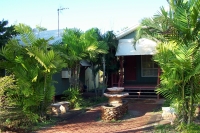 The funeral rituals had started on Friday, with burial today. We were invited to share in the celebration of their life. There were many different groups, each doing a different dance to move the spirit along. The males from one side were doing athletic moves, while women did a separate but related dance. We felt very privileged to have this opportunity, as it isn’t granted lightly to outsiders. We were permitted, indeed encouraged, to take photographs, on the understanding that they are not to be published anywhere.
The funeral rituals had started on Friday, with burial today. We were invited to share in the celebration of their life. There were many different groups, each doing a different dance to move the spirit along. The males from one side were doing athletic moves, while women did a separate but related dance. We felt very privileged to have this opportunity, as it isn’t granted lightly to outsiders. We were permitted, indeed encouraged, to take photographs, on the understanding that they are not to be published anywhere.
The ceremonies all took place outdoors, in the space between several houses. The coffin was inside a bough shed, constructed by tying palm fronds and other vegetation around the supports of a more permanent open-sided shade construction (rather like a covered patio, but with no floor). The grave had been dug in the yard, something that startled us, as I’m sure this isn’t permitted in a city! People sat around under trees and other shade, mostly on blankets, but we were provided with chairs — something Jean’s bad knees very much appreciated. Everyone came and went as needed, and ate lunch from coolers, while the dancing went on in the central area next to the grave.
 Many people had come to the funeral, some from quite a distance. Numerous dome tents (the sort anyone would use for camping) were scattered around the houses. The facilities of the community were quite strained by all the visitors and the fact that the weekly supply barge was late — it should have arrived on Tuesday, but hadn’t come.
Many people had come to the funeral, some from quite a distance. Numerous dome tents (the sort anyone would use for camping) were scattered around the houses. The facilities of the community were quite strained by all the visitors and the fact that the weekly supply barge was late — it should have arrived on Tuesday, but hadn’t come.
As far as we know, we were the first visit by a tour group to this community, but they are planning to open the community to more visitors. We stayed overnight in the guest house, normally used for visiting government officials. The facilities were quite basic: mostly single rooms, a common room, a kitchen, a laundry room, and showers/toilets. Reminded us of a residence hall at a university. Contact Milingimbi Community Council, Milingimbi via Darwin NT 0822, phone (08) 8987 9905.
Day 11, Thursday 21 August, Gove Peninsula
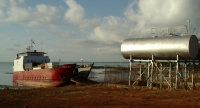
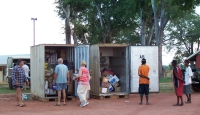 In the morning we got up early to go down to the wharf and see the barge come in and unload. It has to be timed to the tides, so the unloading was fast and efficient. Fuel, building materials, food, and everything else needed by the community was unloaded and stacked up on the shore. People carried off their share in cars, on tractors, in wheelbarrows — it was quite a procession.
In the morning we got up early to go down to the wharf and see the barge come in and unload. It has to be timed to the tides, so the unloading was fast and efficient. Fuel, building materials, food, and everything else needed by the community was unloaded and stacked up on the shore. People carried off their share in cars, on tractors, in wheelbarrows — it was quite a procession.
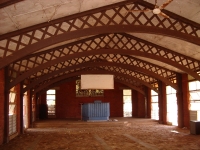 Afterwards, we looked around the town and the surrounding area a bit, at the school and some of the old buildings, including a mission church in sad need of repair, aircraft remains (from WWII), sacred waterholes, and other natural features (trees, birds, animals).
Afterwards, we looked around the town and the surrounding area a bit, at the school and some of the old buildings, including a mission church in sad need of repair, aircraft remains (from WWII), sacred waterholes, and other natural features (trees, birds, animals).
 At lunch we also had the opportunity to examine some local artwork, and talk some more with Gunja and other women of the community. At one point one of our group asked Gunja for her full name and mailing address so they could send her something. To help with spelling, Gunja pulled from her bag her passport. Turns out she had been to Europe and other places as part of Aboriginal delegations to various conferences.
At lunch we also had the opportunity to examine some local artwork, and talk some more with Gunja and other women of the community. At one point one of our group asked Gunja for her full name and mailing address so they could send her something. To help with spelling, Gunja pulled from her bag her passport. Turns out she had been to Europe and other places as part of Aboriginal delegations to various conferences.
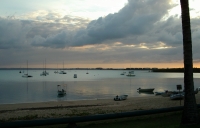 Later we flew to the Gove Peninsula in Northeastern Arnhem Land. We were given a quick vehicle tour of Melville Bay, the town of Nhulunbuy, the bauxite mine, the Yacht Club and the Nambarra Art and Crafts Centre at Yirrkala, where our group purchased lots of art. This place has a superb selection of Yolngu artwork for sale.
Later we flew to the Gove Peninsula in Northeastern Arnhem Land. We were given a quick vehicle tour of Melville Bay, the town of Nhulunbuy, the bauxite mine, the Yacht Club and the Nambarra Art and Crafts Centre at Yirrkala, where our group purchased lots of art. This place has a superb selection of Yolngu artwork for sale.
It also contains a historical museum, featuring photos, artifacts, and other information about (among other things) the Macassan fishermen and traders from Indonesia, who visited these lands centuries ago and traded with the Aboriginal people.
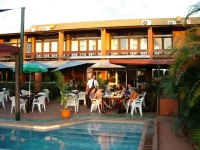 The museum also features a copy of the now famous “Bark Petitions” presented to the Commonwealth Parliament in 1963. These petitions were the first traditional documents recognised by the Commonwealth Parliament. They began a chain of events that eventually led to the 1976 Northern Territory Land Rights Act, under which Arnhem Land was returned to its Aboriginal owners.
The museum also features a copy of the now famous “Bark Petitions” presented to the Commonwealth Parliament in 1963. These petitions were the first traditional documents recognised by the Commonwealth Parliament. They began a chain of events that eventually led to the 1976 Northern Territory Land Rights Act, under which Arnhem Land was returned to its Aboriginal owners.
Lots more information about the area, the art, and the petitions, is here:
http://www.foundingdocs.gov.au/item.asp?dID=104
http://www.aboriginalartonline.com/regions/yirrkala.php
http://www.aboriginalartonline.com/regions/topend.html
http://walkabout.com.au/locations/NTGove.shtml
We stayed overnight at the Walkabout Lodge, PO Box 221, Nhulunbuy NT 0881, phone (08) 8987 1777.
Page last updated 6 October 2007.
